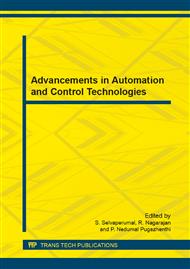[1]
Hussam AL-Atrash, et. al, Effect of Measurement Noise and Bias on Hill-Climbing MPPT Algorithms, IEEE Transactions on Aerospace and Electronic Systems vol. 46, no. 2, April (2010).
DOI: 10.1109/taes.2010.5461654
Google Scholar
[2]
F. Liu, et. al., Comparison of P&O and Hill climbing MPPT methods for grid-connected PV CZonverter, in proc. 2008, 3rd IEEE Industrial Electronics and Applications Conference, p.804 – 807.
DOI: 10.1109/iciea.2008.4582626
Google Scholar
[3]
Nicola Femia, et. al., A Technique for Improving P&O MPPT Performances of Double-Stage Grid-Connected Photovoltaic Systems, IEEE Transactions on Industrial Electronics, vol. 56, no. 11, November 2009, pp.4473-4482.
DOI: 10.1109/tie.2009.2029589
Google Scholar
[4]
Desai, et. al., Maximum power point algorithm in PV Generation—An Overview, in Proceedings. International. Conference. Power Electronics and Drive Systems, 2007, pp.624-630.
DOI: 10.1109/peds.2007.4487766
Google Scholar
[5]
Anil K. Rai, Simulation model of ANN based maximum power point tracking controller for solar PV system, Solar Energy Materials & Solar Cells 95 (2011) 773–778.
DOI: 10.1016/j.solmat.2010.10.022
Google Scholar
[6]
Theodoros L. Kottas, et. al., New Maximum Power Point Tracker for PV Arrays Using Fuzzy Controller in Close Cooperation With Fuzzy Cognitive Networks, IEEE Transactions on Energy Conversion, vol. 21, no. 3, September 2006, pp.793-803.
DOI: 10.1109/tec.2006.875430
Google Scholar
[7]
Trishan Esram et. al., Comparison of Photovoltaic Array Maximum Power Point Tracking Techniques, IEEE Transactions on Energy Conversions, vol. 22, no. 2, June 2007, pp.439-449.
DOI: 10.1109/tec.2006.874230
Google Scholar
[8]
J.M. Enrique, et. al., Theoretical assessment of the maximum power point tracking efficiency of photovoltaic facilities with different converter topologies, Solar Energy 81 (2007) , p.31–38.
DOI: 10.1016/j.solener.2006.06.006
Google Scholar
[9]
Marcelo Gradella Villalva , et. al., Comprehensive Approach to Modeling and Simulation of Photovoltaic Arrays, IEEE Transactions on Power Electronics, vol. 24, no. 5, May 2009, pp.1198-1208.
DOI: 10.1109/tpel.2009.2013862
Google Scholar
[10]
RanDall Shaffer, Fundamentals of power electronics with MATLAB, Firewall Media (An Imprint of Laxmi Publications. Pvt. Ltd).
Google Scholar
[11]
D. P. Hohm, et. al., Comparative Study of Maximum Power Point Tracking Algorithms, Progress in Photovoltaics: Research and Applications , 2003; 11: 47– 62 (DOI: 10. 1002/pip. 459).
DOI: 10.1002/pip.459
Google Scholar


